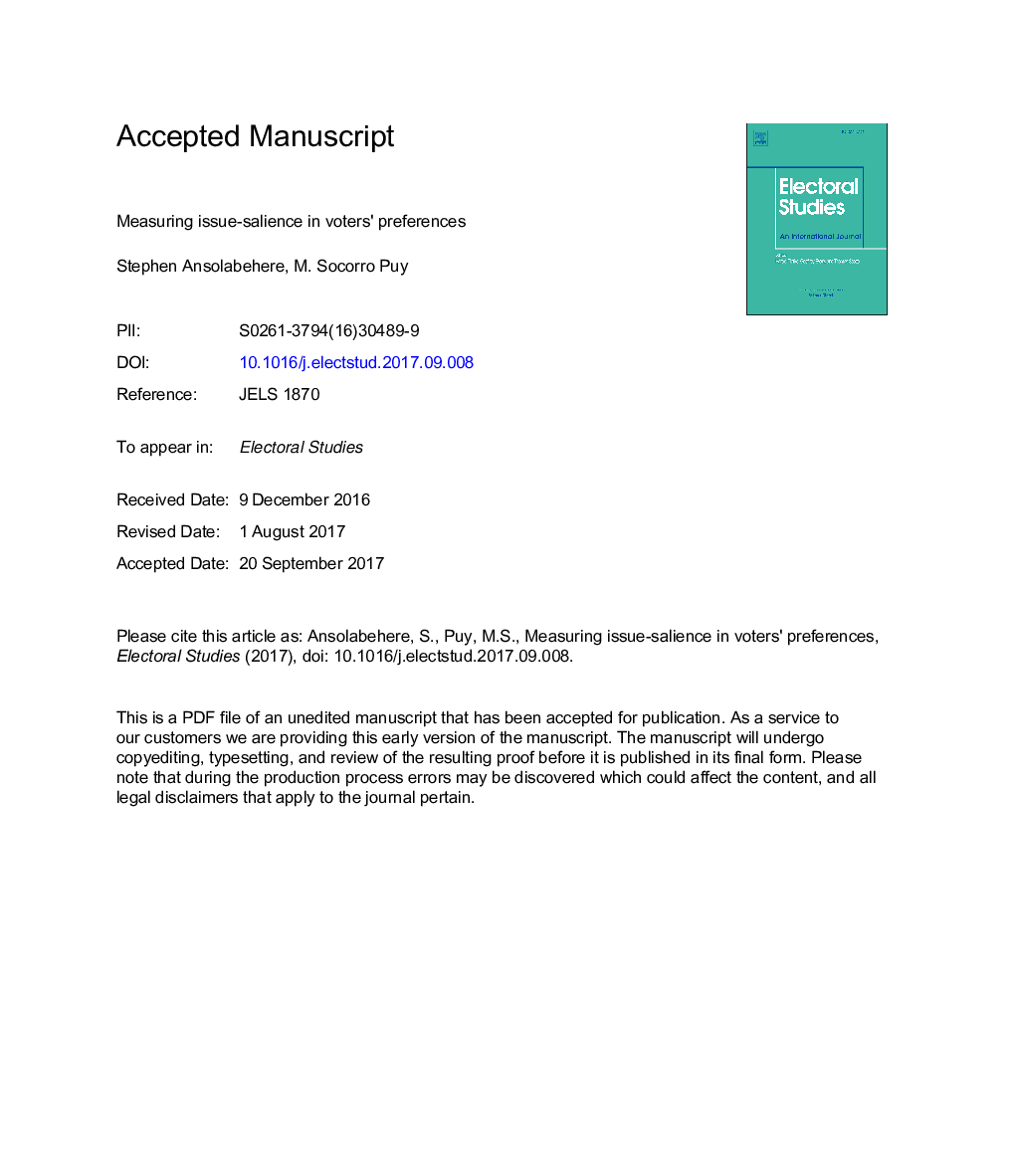| کد مقاله | کد نشریه | سال انتشار | مقاله انگلیسی | نسخه تمام متن |
|---|---|---|---|---|
| 7463349 | 1484942 | 2018 | 37 صفحه PDF | دانلود رایگان |
عنوان انگلیسی مقاله ISI
Measuring issue-salience in voters' preferences
ترجمه فارسی عنوان
اندازه گیری مسئله مهم در تنظیمات رأی دهندگان
دانلود مقاله + سفارش ترجمه
دانلود مقاله ISI انگلیسی
رایگان برای ایرانیان
کلمات کلیدی
رأی دادن، اهمیت، آغازگر ایدئولوژی، ملیگرایی،
ترجمه چکیده
ما یک رویکرد جدید برای اندازه گیری مسئله مهم ارائه می دهیم که توضیح می دهد که چقدر اهمیت یک موضوع در میان رای دهندگان و موقعیت طرفین در مورد یک موضوع مشخص در تعامل با یکدیگر و تعیین انتخاب رأی و نتایج کل نتایج انتخابات است. با تجزیه و تحلیل مدل فضایی رأی گیری، ما نشان می دهیم که چگونه احتمال رأی گیری را می توان با یک رگرسیون چندجملهای منطقی تخمین زد که در آن موقعیت های مطلوب سیاست رای دهندگان در هر ابعاد موضوع، متغیرهای مستقل و بدون درک فردی خاص درباره مکان احزاب سیاسی است در رگرسیون بخش هایی از اطلاعات نظرسنجی که برای محاسبه مسئله مورد استفاده قرار می گیرند، عبارتند از: 1) موقعیت خاص پاسخ دهندگان در هر بعد موضوع، 2) انتخاب رای، و 3) موقعیت سیاسی احزاب در هر بعد موضوعی، که با میانگین موقعیت درک شده در عوض، فقط یک ارزیابی کلی از موقعیت های حزبی در مورد مسائل مورد نیاز است. برای نشان دادن مکانیسم و ارزش رویکرد، ما انتخابات منطقه ای در استان باسک اسپانیا را تجزیه و تحلیل می کنیم. در آن منطقه، متوجه می شویم که ابعاد سمت چپ و راست تقریبا دو برابر برجسته تر از ملی گرایی است. با این وجود، مسئله ملی گرایی بیشتر از موضوع چپ و راست تقسیم می شود. این نشان می دهد که مسئله ای که رای دهندگان در مورد آن بیشتر توجه می کنند، ممکن است با مسئله ای که طرفین سیاست های متمایزتری را ارائه می دهند، منطبق نباشد.
موضوعات مرتبط
علوم انسانی و اجتماعی
علوم اجتماعی
جغرافیا، برنامه ریزی و توسعه
چکیده انگلیسی
We provide a new approach to the measurement of issue salience that explains how the salience of an issue among voters and the position of the parties on a given issue interact to each other and determine vote choices and aggregate election results. Analyzing the spatial model of voting, we show how voting probabilities can be estimated by a multinomial logit regression where the ideal policy locations of voters on each issue dimensions are independent variables, and where no individual specific perception about the location of the political parties is used in the regression. The pieces of survey information that are used to calculate issue-salience are: i) specific position of respondents on each issue dimension, ii) vote choice, and iii) the policy position of parties on each issue dimension, which is measured by the mean perceived position. Rather, only an aggregate estimate of party positions on issues is needed. To demonstrate the mechanics and value of the approach, we analyze regional elections in the Basque province of Spain. In that region, we find that the left-right dimension is about two times more salient than nationalism. The nationalism issue is, however, more divisive than the left-right issue. This shows that the issue that voters care more about, may not coincide with the issue on which the parties offer more distinctive policies.
ناشر
Database: Elsevier - ScienceDirect (ساینس دایرکت)
Journal: Electoral Studies - Volume 51, February 2018, Pages 103-114
Journal: Electoral Studies - Volume 51, February 2018, Pages 103-114
نویسندگان
Stephen Ansolabehere, M. Socorro Puy,
